Financial Reporting Report: Financial Reporting Standards and Analysis
VerifiedAdded on 2021/01/05
|30
|4693
|90
Report
AI Summary
This report delves into the core aspects of financial reporting, commencing with an introduction to its context and purpose, emphasizing its role in measuring organizational performance and providing crucial information to stakeholders such as management, investors, and government entities. The report then explores the conceptual and regulatory frameworks, including the qualitative characteristics that underpin reliable financial reporting. It highlights the significance of financial information for various stakeholders and their roles in organizational growth and objectives. The report also examines the framing of financial statements in accordance with IAS 1, followed by an interpretation of Glaxo Smith Plc's financial performance using profitability ratios. A comparative analysis of IAS and IFRS is presented, including the benefits of IFRS adoption and compliance considerations. The report concludes by summarizing the importance of financial reporting in achieving organizational goals and objectives, providing a comprehensive understanding of financial reporting principles and their practical applications.
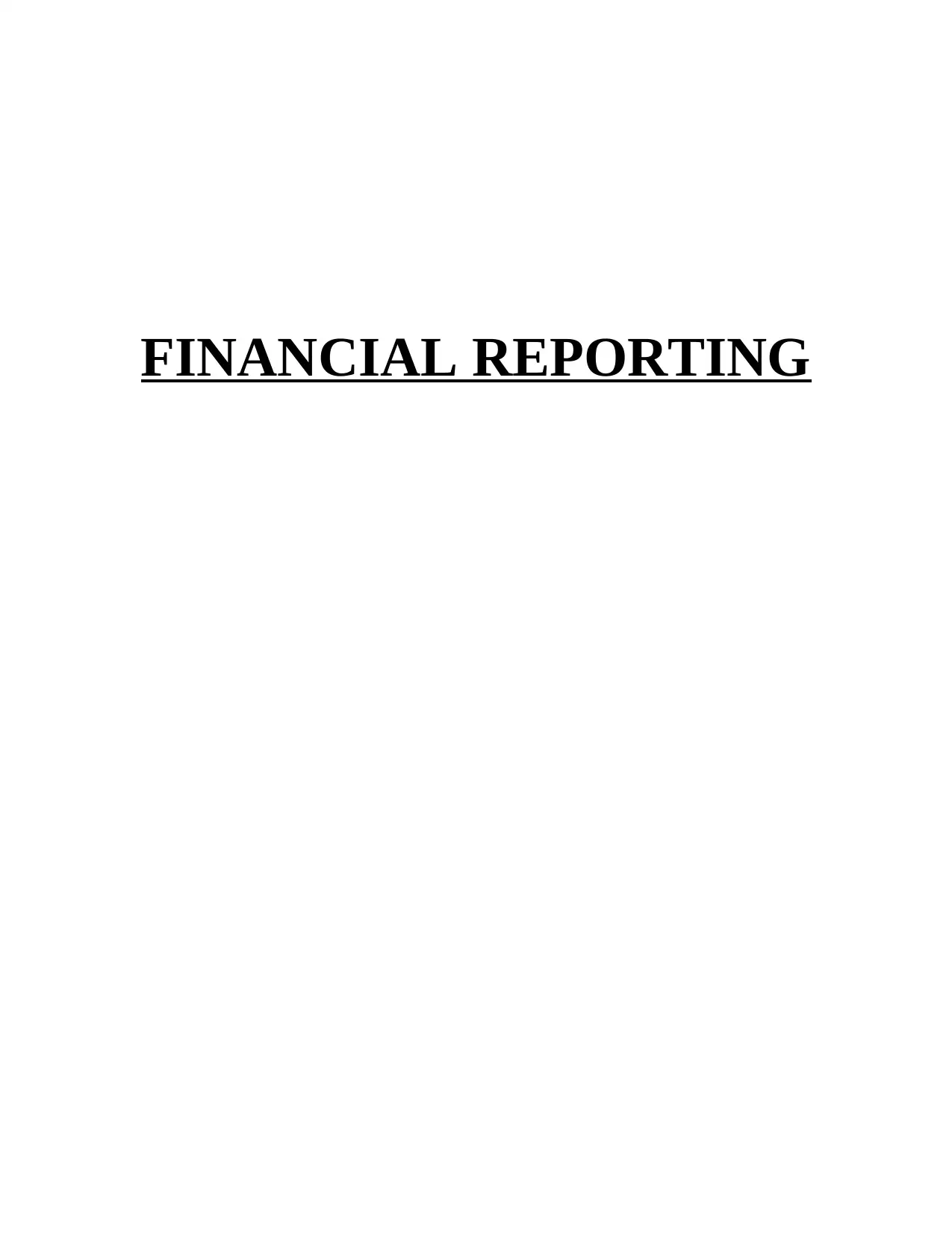
FINANCIAL REPORTING
Paraphrase This Document
Need a fresh take? Get an instant paraphrase of this document with our AI Paraphraser
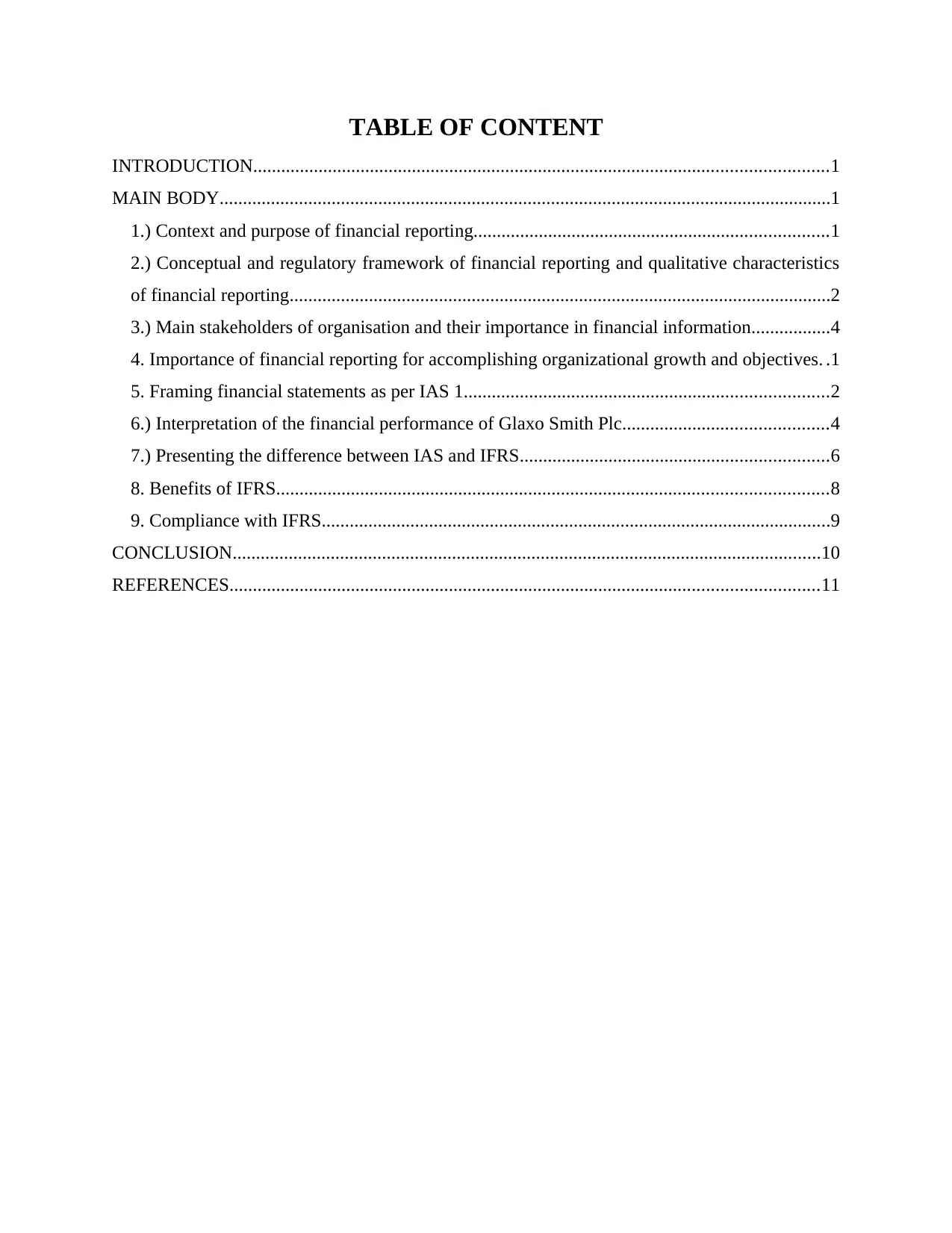
TABLE OF CONTENT
INTRODUCTION...........................................................................................................................1
MAIN BODY...................................................................................................................................1
1.) Context and purpose of financial reporting............................................................................1
2.) Conceptual and regulatory framework of financial reporting and qualitative characteristics
of financial reporting....................................................................................................................2
3.) Main stakeholders of organisation and their importance in financial information.................4
4. Importance of financial reporting for accomplishing organizational growth and objectives. .1
5. Framing financial statements as per IAS 1..............................................................................2
6.) Interpretation of the financial performance of Glaxo Smith Plc............................................4
7.) Presenting the difference between IAS and IFRS..................................................................6
8. Benefits of IFRS......................................................................................................................8
9. Compliance with IFRS.............................................................................................................9
CONCLUSION..............................................................................................................................10
REFERENCES..............................................................................................................................11
INTRODUCTION...........................................................................................................................1
MAIN BODY...................................................................................................................................1
1.) Context and purpose of financial reporting............................................................................1
2.) Conceptual and regulatory framework of financial reporting and qualitative characteristics
of financial reporting....................................................................................................................2
3.) Main stakeholders of organisation and their importance in financial information.................4
4. Importance of financial reporting for accomplishing organizational growth and objectives. .1
5. Framing financial statements as per IAS 1..............................................................................2
6.) Interpretation of the financial performance of Glaxo Smith Plc............................................4
7.) Presenting the difference between IAS and IFRS..................................................................6
8. Benefits of IFRS......................................................................................................................8
9. Compliance with IFRS.............................................................................................................9
CONCLUSION..............................................................................................................................10
REFERENCES..............................................................................................................................11
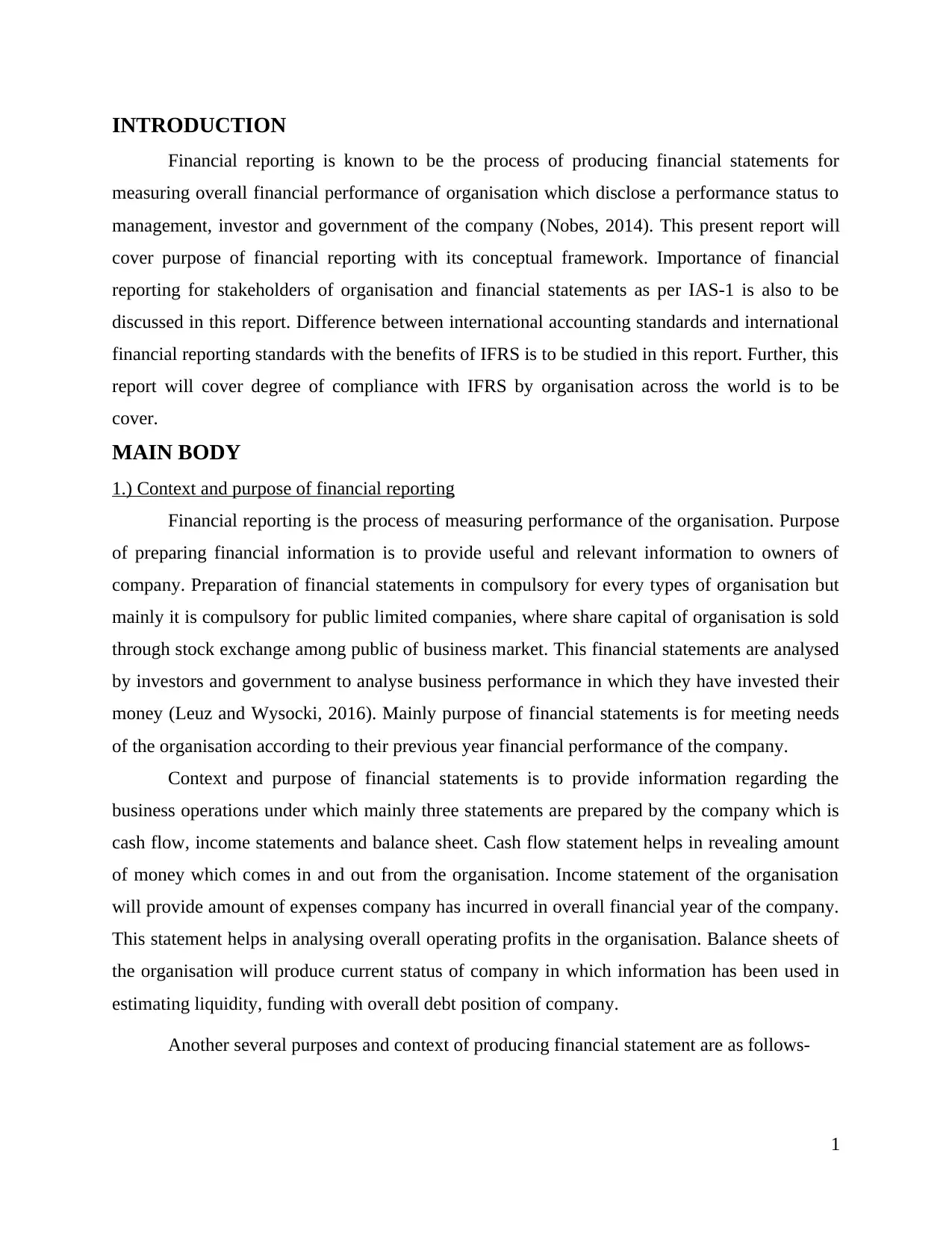
INTRODUCTION
Financial reporting is known to be the process of producing financial statements for
measuring overall financial performance of organisation which disclose a performance status to
management, investor and government of the company (Nobes, 2014). This present report will
cover purpose of financial reporting with its conceptual framework. Importance of financial
reporting for stakeholders of organisation and financial statements as per IAS-1 is also to be
discussed in this report. Difference between international accounting standards and international
financial reporting standards with the benefits of IFRS is to be studied in this report. Further, this
report will cover degree of compliance with IFRS by organisation across the world is to be
cover.
MAIN BODY
1.) Context and purpose of financial reporting
Financial reporting is the process of measuring performance of the organisation. Purpose
of preparing financial information is to provide useful and relevant information to owners of
company. Preparation of financial statements in compulsory for every types of organisation but
mainly it is compulsory for public limited companies, where share capital of organisation is sold
through stock exchange among public of business market. This financial statements are analysed
by investors and government to analyse business performance in which they have invested their
money (Leuz and Wysocki, 2016). Mainly purpose of financial statements is for meeting needs
of the organisation according to their previous year financial performance of the company.
Context and purpose of financial statements is to provide information regarding the
business operations under which mainly three statements are prepared by the company which is
cash flow, income statements and balance sheet. Cash flow statement helps in revealing amount
of money which comes in and out from the organisation. Income statement of the organisation
will provide amount of expenses company has incurred in overall financial year of the company.
This statement helps in analysing overall operating profits in the organisation. Balance sheets of
the organisation will produce current status of company in which information has been used in
estimating liquidity, funding with overall debt position of company.
Another several purposes and context of producing financial statement are as follows-
1
Financial reporting is known to be the process of producing financial statements for
measuring overall financial performance of organisation which disclose a performance status to
management, investor and government of the company (Nobes, 2014). This present report will
cover purpose of financial reporting with its conceptual framework. Importance of financial
reporting for stakeholders of organisation and financial statements as per IAS-1 is also to be
discussed in this report. Difference between international accounting standards and international
financial reporting standards with the benefits of IFRS is to be studied in this report. Further, this
report will cover degree of compliance with IFRS by organisation across the world is to be
cover.
MAIN BODY
1.) Context and purpose of financial reporting
Financial reporting is the process of measuring performance of the organisation. Purpose
of preparing financial information is to provide useful and relevant information to owners of
company. Preparation of financial statements in compulsory for every types of organisation but
mainly it is compulsory for public limited companies, where share capital of organisation is sold
through stock exchange among public of business market. This financial statements are analysed
by investors and government to analyse business performance in which they have invested their
money (Leuz and Wysocki, 2016). Mainly purpose of financial statements is for meeting needs
of the organisation according to their previous year financial performance of the company.
Context and purpose of financial statements is to provide information regarding the
business operations under which mainly three statements are prepared by the company which is
cash flow, income statements and balance sheet. Cash flow statement helps in revealing amount
of money which comes in and out from the organisation. Income statement of the organisation
will provide amount of expenses company has incurred in overall financial year of the company.
This statement helps in analysing overall operating profits in the organisation. Balance sheets of
the organisation will produce current status of company in which information has been used in
estimating liquidity, funding with overall debt position of company.
Another several purposes and context of producing financial statement are as follows-
1
⊘ This is a preview!⊘
Do you want full access?
Subscribe today to unlock all pages.

Trusted by 1+ million students worldwide
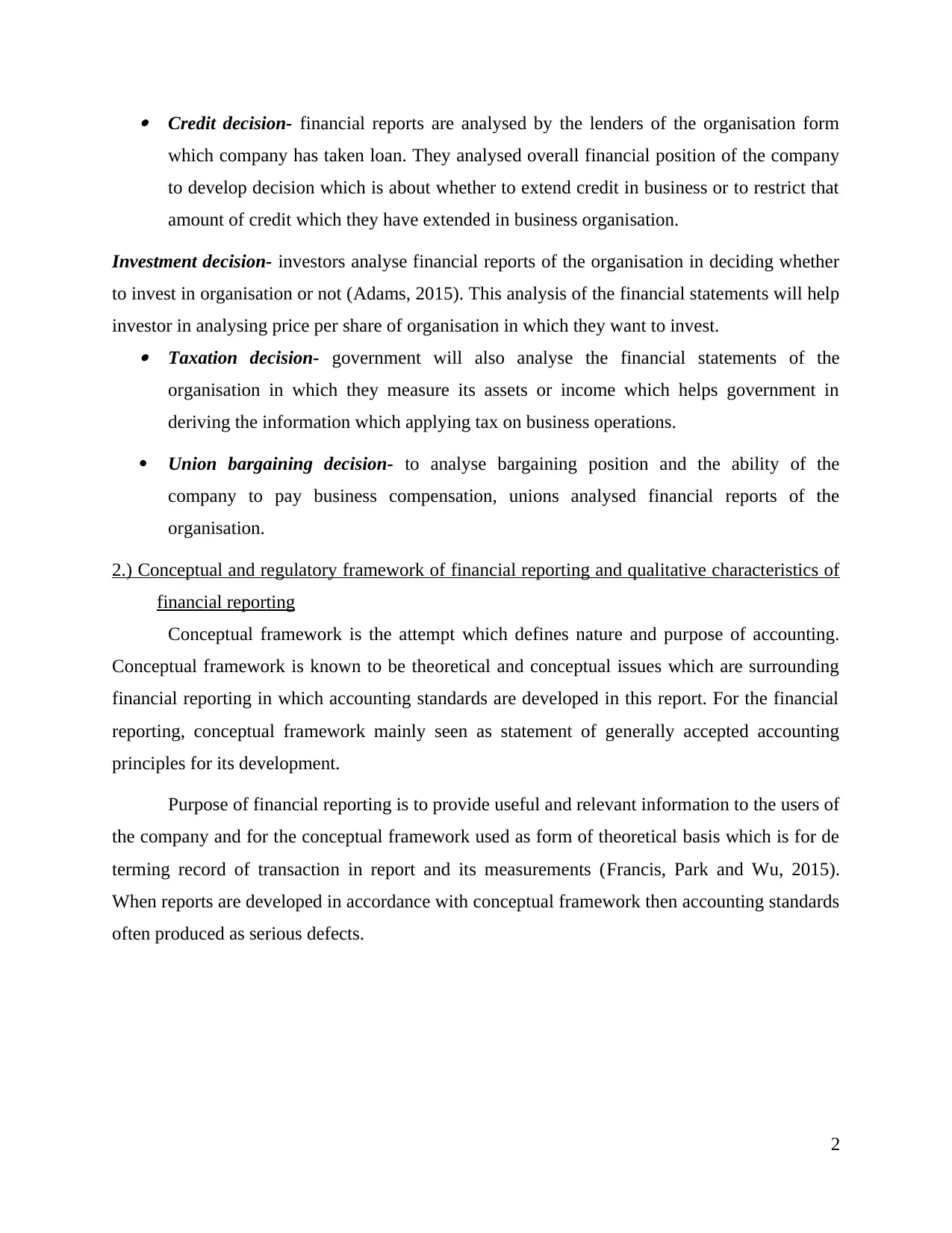
Credit decision- financial reports are analysed by the lenders of the organisation form
which company has taken loan. They analysed overall financial position of the company
to develop decision which is about whether to extend credit in business or to restrict that
amount of credit which they have extended in business organisation.
Investment decision- investors analyse financial reports of the organisation in deciding whether
to invest in organisation or not (Adams, 2015). This analysis of the financial statements will help
investor in analysing price per share of organisation in which they want to invest. Taxation decision- government will also analyse the financial statements of the
organisation in which they measure its assets or income which helps government in
deriving the information which applying tax on business operations.
Union bargaining decision- to analyse bargaining position and the ability of the
company to pay business compensation, unions analysed financial reports of the
organisation.
2.) Conceptual and regulatory framework of financial reporting and qualitative characteristics of
financial reporting
Conceptual framework is the attempt which defines nature and purpose of accounting.
Conceptual framework is known to be theoretical and conceptual issues which are surrounding
financial reporting in which accounting standards are developed in this report. For the financial
reporting, conceptual framework mainly seen as statement of generally accepted accounting
principles for its development.
Purpose of financial reporting is to provide useful and relevant information to the users of
the company and for the conceptual framework used as form of theoretical basis which is for de
terming record of transaction in report and its measurements (Francis, Park and Wu, 2015).
When reports are developed in accordance with conceptual framework then accounting standards
often produced as serious defects.
2
which company has taken loan. They analysed overall financial position of the company
to develop decision which is about whether to extend credit in business or to restrict that
amount of credit which they have extended in business organisation.
Investment decision- investors analyse financial reports of the organisation in deciding whether
to invest in organisation or not (Adams, 2015). This analysis of the financial statements will help
investor in analysing price per share of organisation in which they want to invest. Taxation decision- government will also analyse the financial statements of the
organisation in which they measure its assets or income which helps government in
deriving the information which applying tax on business operations.
Union bargaining decision- to analyse bargaining position and the ability of the
company to pay business compensation, unions analysed financial reports of the
organisation.
2.) Conceptual and regulatory framework of financial reporting and qualitative characteristics of
financial reporting
Conceptual framework is the attempt which defines nature and purpose of accounting.
Conceptual framework is known to be theoretical and conceptual issues which are surrounding
financial reporting in which accounting standards are developed in this report. For the financial
reporting, conceptual framework mainly seen as statement of generally accepted accounting
principles for its development.
Purpose of financial reporting is to provide useful and relevant information to the users of
the company and for the conceptual framework used as form of theoretical basis which is for de
terming record of transaction in report and its measurements (Francis, Park and Wu, 2015).
When reports are developed in accordance with conceptual framework then accounting standards
often produced as serious defects.
2
Paraphrase This Document
Need a fresh take? Get an instant paraphrase of this document with our AI Paraphraser
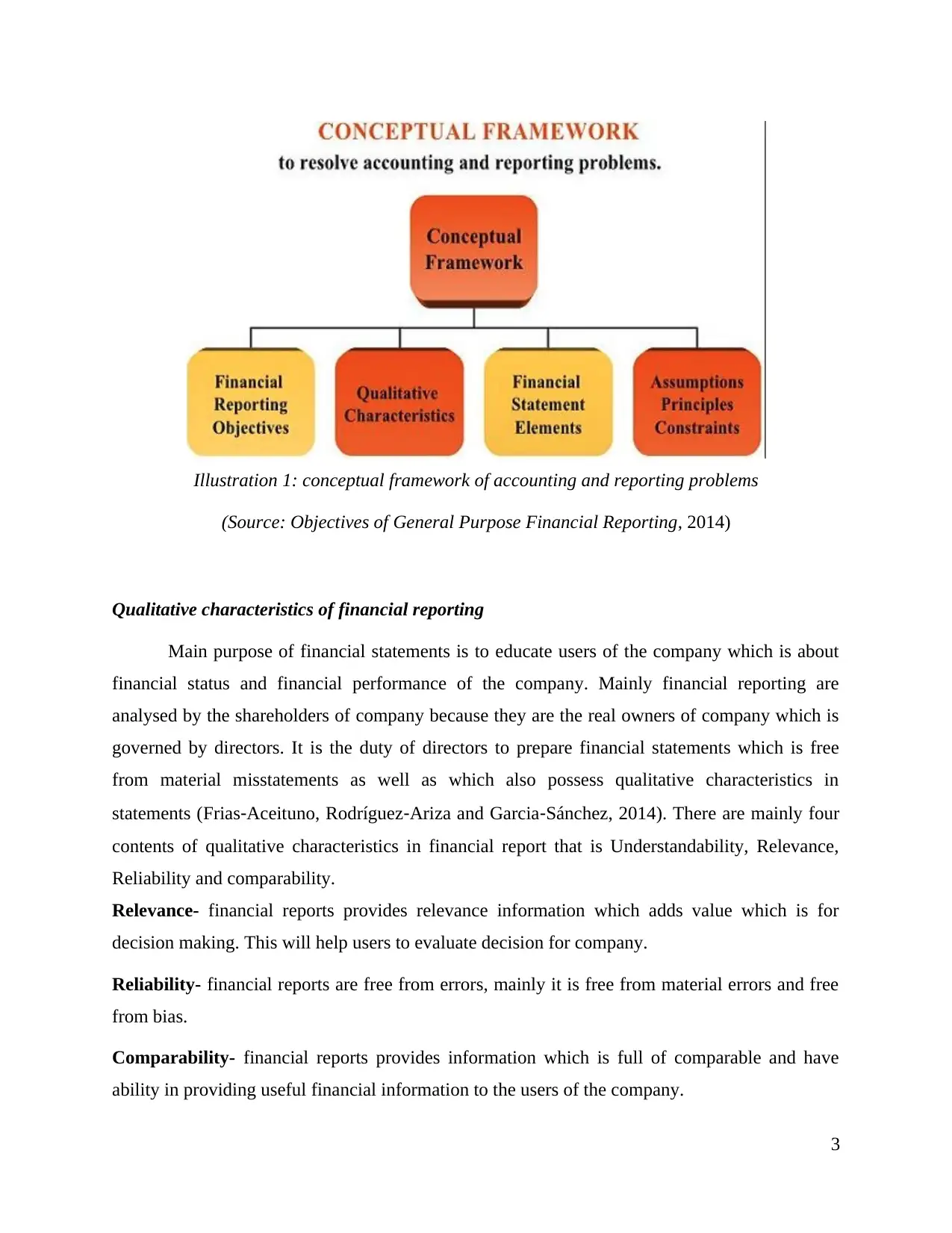
Qualitative characteristics of financial reporting
Main purpose of financial statements is to educate users of the company which is about
financial status and financial performance of the company. Mainly financial reporting are
analysed by the shareholders of company because they are the real owners of company which is
governed by directors. It is the duty of directors to prepare financial statements which is free
from material misstatements as well as which also possess qualitative characteristics in
statements (Frias‐Aceituno, Rodríguez‐Ariza and Garcia‐Sánchez, 2014). There are mainly four
contents of qualitative characteristics in financial report that is Understandability, Relevance,
Reliability and comparability.
Relevance- financial reports provides relevance information which adds value which is for
decision making. This will help users to evaluate decision for company.
Reliability- financial reports are free from errors, mainly it is free from material errors and free
from bias.
Comparability- financial reports provides information which is full of comparable and have
ability in providing useful financial information to the users of the company.
3
Illustration 1: conceptual framework of accounting and reporting problems
(Source: Objectives of General Purpose Financial Reporting, 2014)
Main purpose of financial statements is to educate users of the company which is about
financial status and financial performance of the company. Mainly financial reporting are
analysed by the shareholders of company because they are the real owners of company which is
governed by directors. It is the duty of directors to prepare financial statements which is free
from material misstatements as well as which also possess qualitative characteristics in
statements (Frias‐Aceituno, Rodríguez‐Ariza and Garcia‐Sánchez, 2014). There are mainly four
contents of qualitative characteristics in financial report that is Understandability, Relevance,
Reliability and comparability.
Relevance- financial reports provides relevance information which adds value which is for
decision making. This will help users to evaluate decision for company.
Reliability- financial reports are free from errors, mainly it is free from material errors and free
from bias.
Comparability- financial reports provides information which is full of comparable and have
ability in providing useful financial information to the users of the company.
3
Illustration 1: conceptual framework of accounting and reporting problems
(Source: Objectives of General Purpose Financial Reporting, 2014)
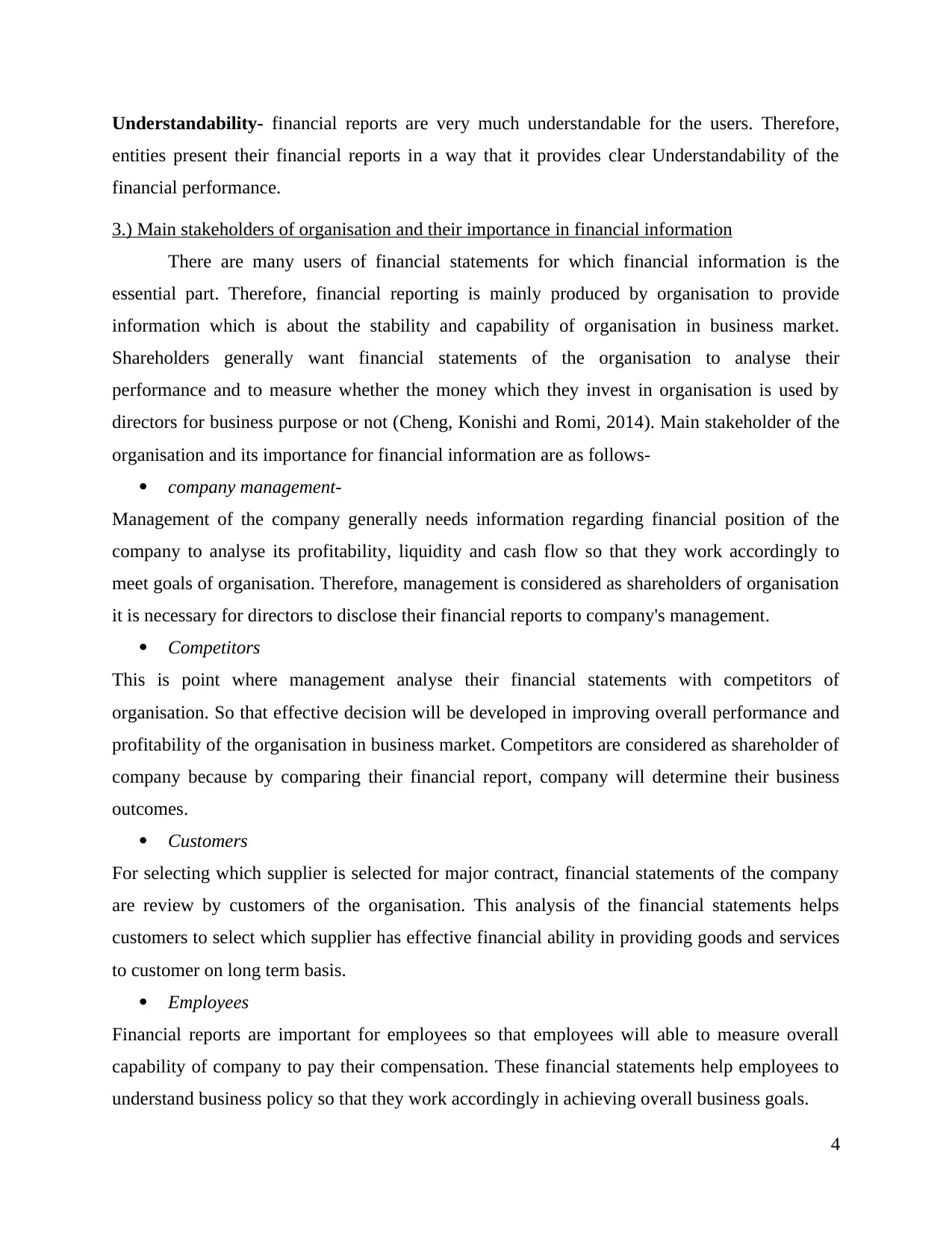
Understandability- financial reports are very much understandable for the users. Therefore,
entities present their financial reports in a way that it provides clear Understandability of the
financial performance.
3.) Main stakeholders of organisation and their importance in financial information
There are many users of financial statements for which financial information is the
essential part. Therefore, financial reporting is mainly produced by organisation to provide
information which is about the stability and capability of organisation in business market.
Shareholders generally want financial statements of the organisation to analyse their
performance and to measure whether the money which they invest in organisation is used by
directors for business purpose or not (Cheng, Konishi and Romi, 2014). Main stakeholder of the
organisation and its importance for financial information are as follows-
company management-
Management of the company generally needs information regarding financial position of the
company to analyse its profitability, liquidity and cash flow so that they work accordingly to
meet goals of organisation. Therefore, management is considered as shareholders of organisation
it is necessary for directors to disclose their financial reports to company's management.
Competitors
This is point where management analyse their financial statements with competitors of
organisation. So that effective decision will be developed in improving overall performance and
profitability of the organisation in business market. Competitors are considered as shareholder of
company because by comparing their financial report, company will determine their business
outcomes.
Customers
For selecting which supplier is selected for major contract, financial statements of the company
are review by customers of the organisation. This analysis of the financial statements helps
customers to select which supplier has effective financial ability in providing goods and services
to customer on long term basis.
Employees
Financial reports are important for employees so that employees will able to measure overall
capability of company to pay their compensation. These financial statements help employees to
understand business policy so that they work accordingly in achieving overall business goals.
4
entities present their financial reports in a way that it provides clear Understandability of the
financial performance.
3.) Main stakeholders of organisation and their importance in financial information
There are many users of financial statements for which financial information is the
essential part. Therefore, financial reporting is mainly produced by organisation to provide
information which is about the stability and capability of organisation in business market.
Shareholders generally want financial statements of the organisation to analyse their
performance and to measure whether the money which they invest in organisation is used by
directors for business purpose or not (Cheng, Konishi and Romi, 2014). Main stakeholder of the
organisation and its importance for financial information are as follows-
company management-
Management of the company generally needs information regarding financial position of the
company to analyse its profitability, liquidity and cash flow so that they work accordingly to
meet goals of organisation. Therefore, management is considered as shareholders of organisation
it is necessary for directors to disclose their financial reports to company's management.
Competitors
This is point where management analyse their financial statements with competitors of
organisation. So that effective decision will be developed in improving overall performance and
profitability of the organisation in business market. Competitors are considered as shareholder of
company because by comparing their financial report, company will determine their business
outcomes.
Customers
For selecting which supplier is selected for major contract, financial statements of the company
are review by customers of the organisation. This analysis of the financial statements helps
customers to select which supplier has effective financial ability in providing goods and services
to customer on long term basis.
Employees
Financial reports are important for employees so that employees will able to measure overall
capability of company to pay their compensation. These financial statements help employees to
understand business policy so that they work accordingly in achieving overall business goals.
4
⊘ This is a preview!⊘
Do you want full access?
Subscribe today to unlock all pages.

Trusted by 1+ million students worldwide
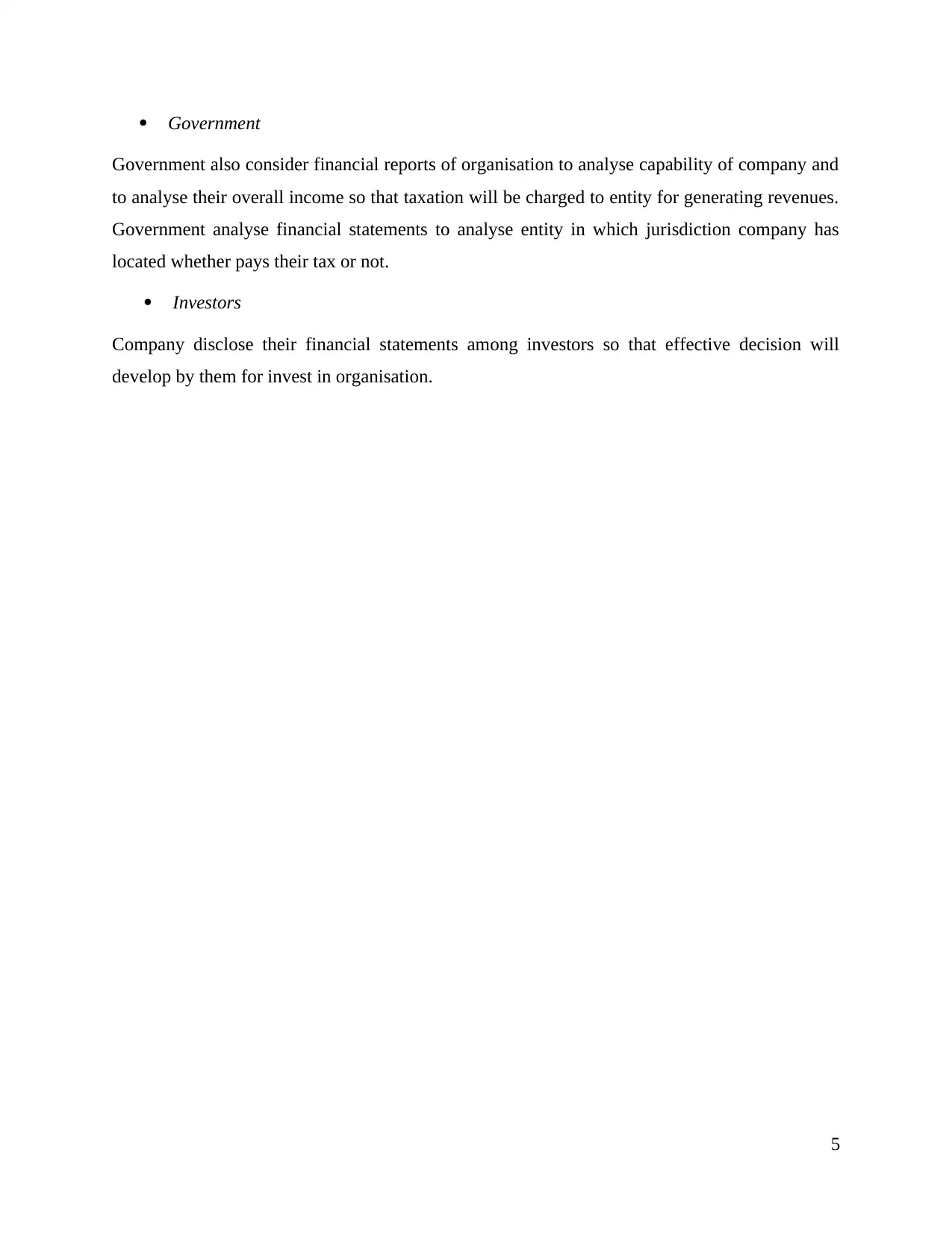
Government
Government also consider financial reports of organisation to analyse capability of company and
to analyse their overall income so that taxation will be charged to entity for generating revenues.
Government analyse financial statements to analyse entity in which jurisdiction company has
located whether pays their tax or not.
Investors
Company disclose their financial statements among investors so that effective decision will
develop by them for invest in organisation.
5
Government also consider financial reports of organisation to analyse capability of company and
to analyse their overall income so that taxation will be charged to entity for generating revenues.
Government analyse financial statements to analyse entity in which jurisdiction company has
located whether pays their tax or not.
Investors
Company disclose their financial statements among investors so that effective decision will
develop by them for invest in organisation.
5
Paraphrase This Document
Need a fresh take? Get an instant paraphrase of this document with our AI Paraphraser
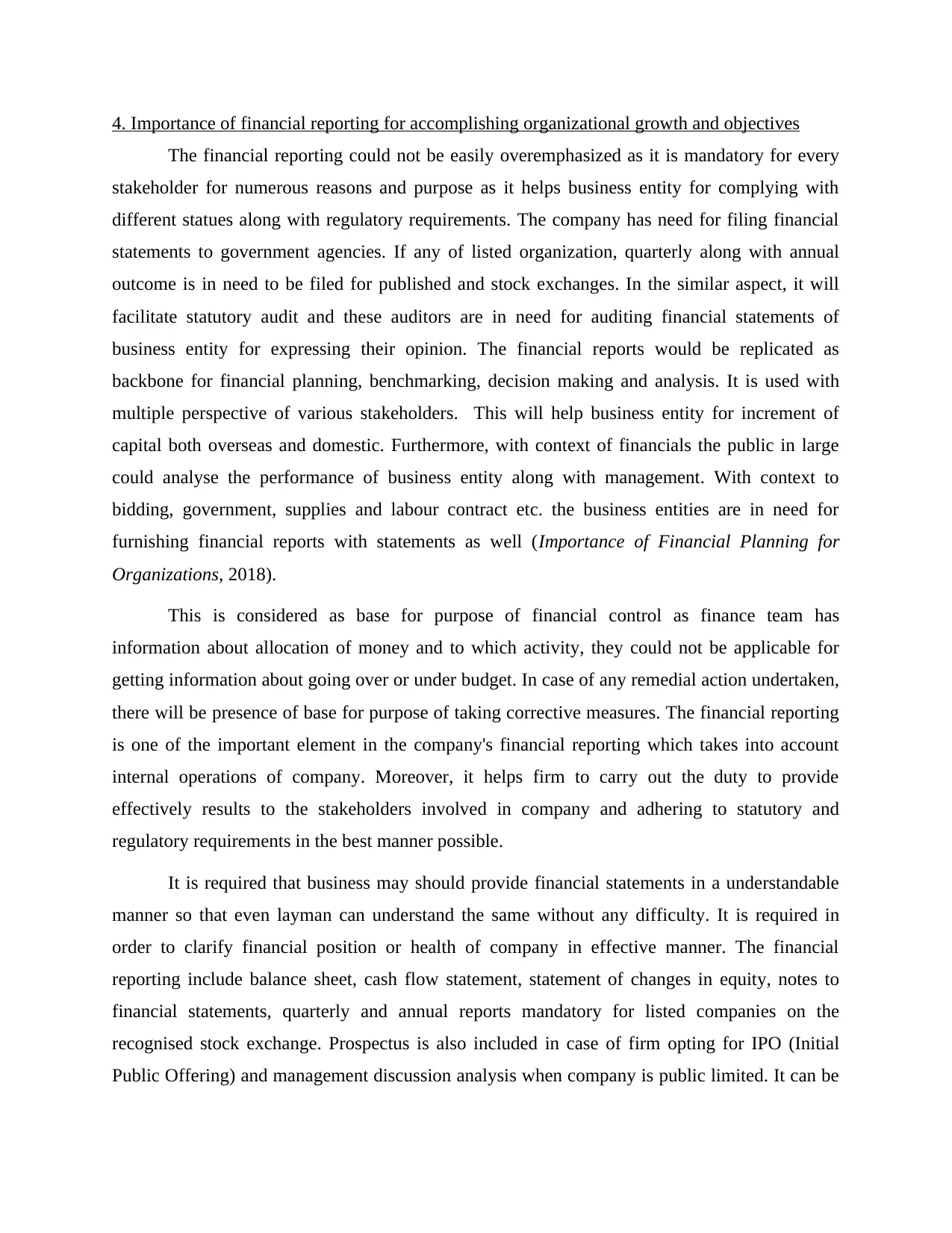
4. Importance of financial reporting for accomplishing organizational growth and objectives
The financial reporting could not be easily overemphasized as it is mandatory for every
stakeholder for numerous reasons and purpose as it helps business entity for complying with
different statues along with regulatory requirements. The company has need for filing financial
statements to government agencies. If any of listed organization, quarterly along with annual
outcome is in need to be filed for published and stock exchanges. In the similar aspect, it will
facilitate statutory audit and these auditors are in need for auditing financial statements of
business entity for expressing their opinion. The financial reports would be replicated as
backbone for financial planning, benchmarking, decision making and analysis. It is used with
multiple perspective of various stakeholders. This will help business entity for increment of
capital both overseas and domestic. Furthermore, with context of financials the public in large
could analyse the performance of business entity along with management. With context to
bidding, government, supplies and labour contract etc. the business entities are in need for
furnishing financial reports with statements as well (Importance of Financial Planning for
Organizations, 2018).
This is considered as base for purpose of financial control as finance team has
information about allocation of money and to which activity, they could not be applicable for
getting information about going over or under budget. In case of any remedial action undertaken,
there will be presence of base for purpose of taking corrective measures. The financial reporting
is one of the important element in the company's financial reporting which takes into account
internal operations of company. Moreover, it helps firm to carry out the duty to provide
effectively results to the stakeholders involved in company and adhering to statutory and
regulatory requirements in the best manner possible.
It is required that business may should provide financial statements in a understandable
manner so that even layman can understand the same without any difficulty. It is required in
order to clarify financial position or health of company in effective manner. The financial
reporting include balance sheet, cash flow statement, statement of changes in equity, notes to
financial statements, quarterly and annual reports mandatory for listed companies on the
recognised stock exchange. Prospectus is also included in case of firm opting for IPO (Initial
Public Offering) and management discussion analysis when company is public limited. It can be
The financial reporting could not be easily overemphasized as it is mandatory for every
stakeholder for numerous reasons and purpose as it helps business entity for complying with
different statues along with regulatory requirements. The company has need for filing financial
statements to government agencies. If any of listed organization, quarterly along with annual
outcome is in need to be filed for published and stock exchanges. In the similar aspect, it will
facilitate statutory audit and these auditors are in need for auditing financial statements of
business entity for expressing their opinion. The financial reports would be replicated as
backbone for financial planning, benchmarking, decision making and analysis. It is used with
multiple perspective of various stakeholders. This will help business entity for increment of
capital both overseas and domestic. Furthermore, with context of financials the public in large
could analyse the performance of business entity along with management. With context to
bidding, government, supplies and labour contract etc. the business entities are in need for
furnishing financial reports with statements as well (Importance of Financial Planning for
Organizations, 2018).
This is considered as base for purpose of financial control as finance team has
information about allocation of money and to which activity, they could not be applicable for
getting information about going over or under budget. In case of any remedial action undertaken,
there will be presence of base for purpose of taking corrective measures. The financial reporting
is one of the important element in the company's financial reporting which takes into account
internal operations of company. Moreover, it helps firm to carry out the duty to provide
effectively results to the stakeholders involved in company and adhering to statutory and
regulatory requirements in the best manner possible.
It is required that business may should provide financial statements in a understandable
manner so that even layman can understand the same without any difficulty. It is required in
order to clarify financial position or health of company in effective manner. The financial
reporting include balance sheet, cash flow statement, statement of changes in equity, notes to
financial statements, quarterly and annual reports mandatory for listed companies on the
recognised stock exchange. Prospectus is also included in case of firm opting for IPO (Initial
Public Offering) and management discussion analysis when company is public limited. It can be
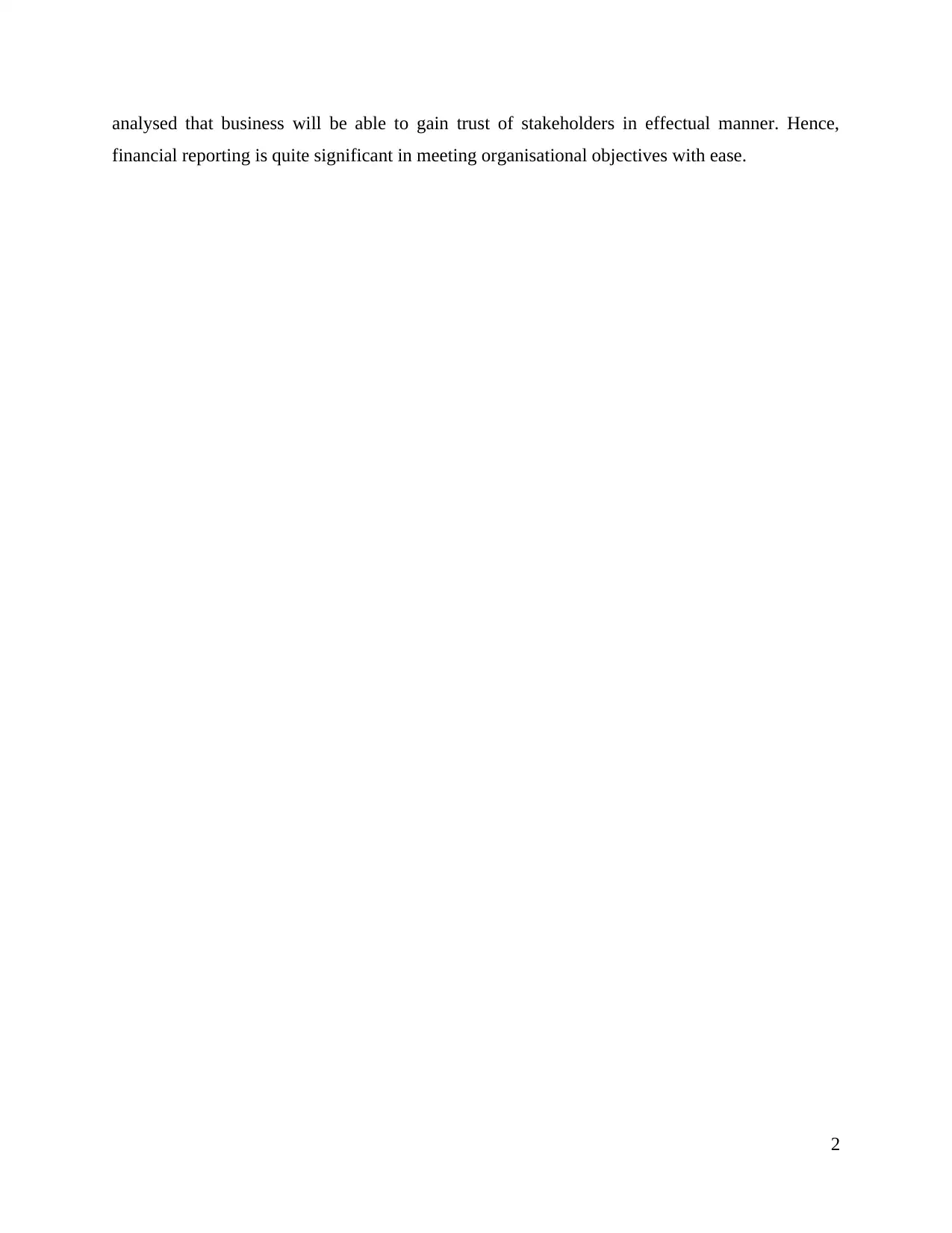
analysed that business will be able to gain trust of stakeholders in effectual manner. Hence,
financial reporting is quite significant in meeting organisational objectives with ease.
2
financial reporting is quite significant in meeting organisational objectives with ease.
2
⊘ This is a preview!⊘
Do you want full access?
Subscribe today to unlock all pages.

Trusted by 1+ million students worldwide
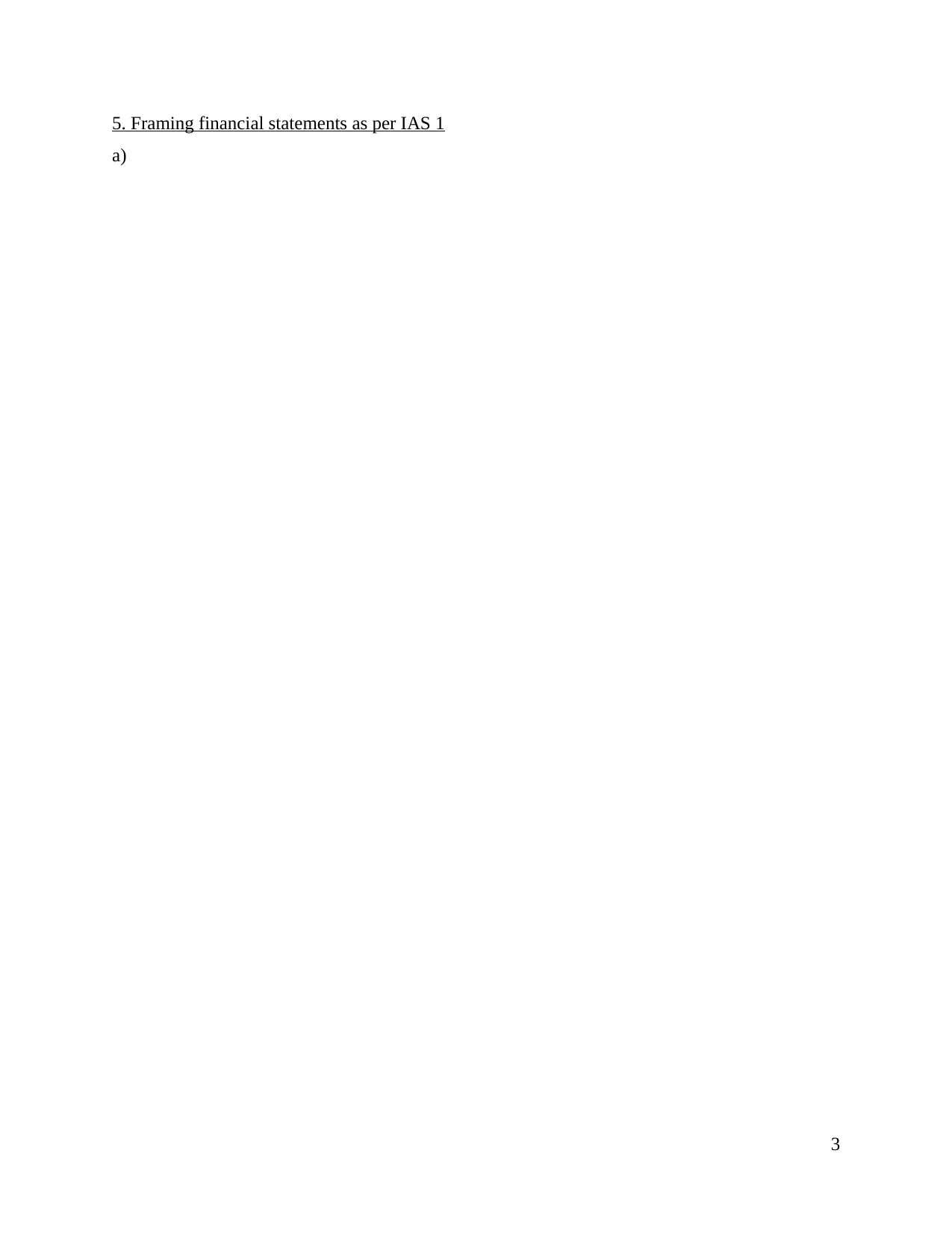
5. Framing financial statements as per IAS 1
a)
3
a)
3
Paraphrase This Document
Need a fresh take? Get an instant paraphrase of this document with our AI Paraphraser
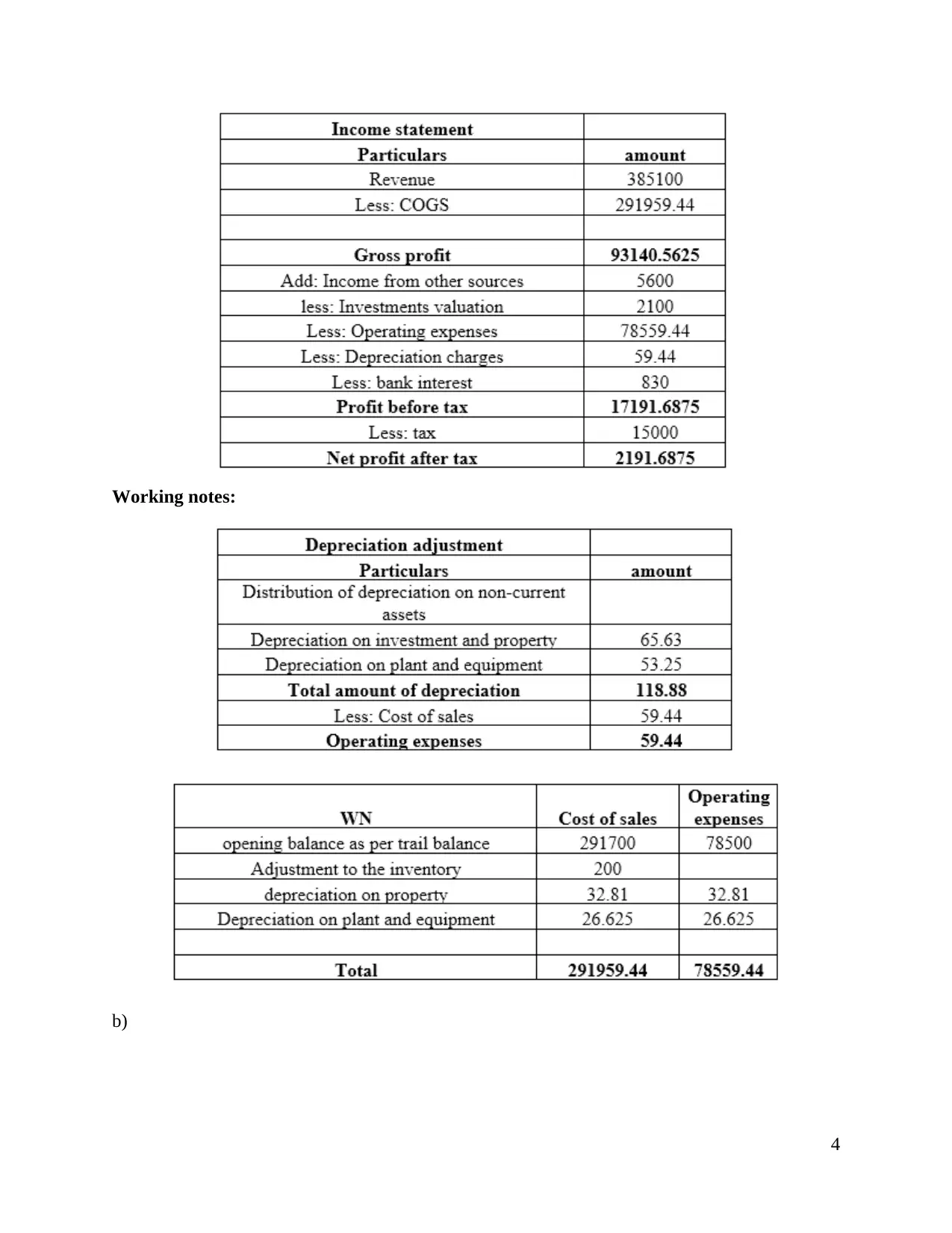
Working notes:
b)
4
b)
4
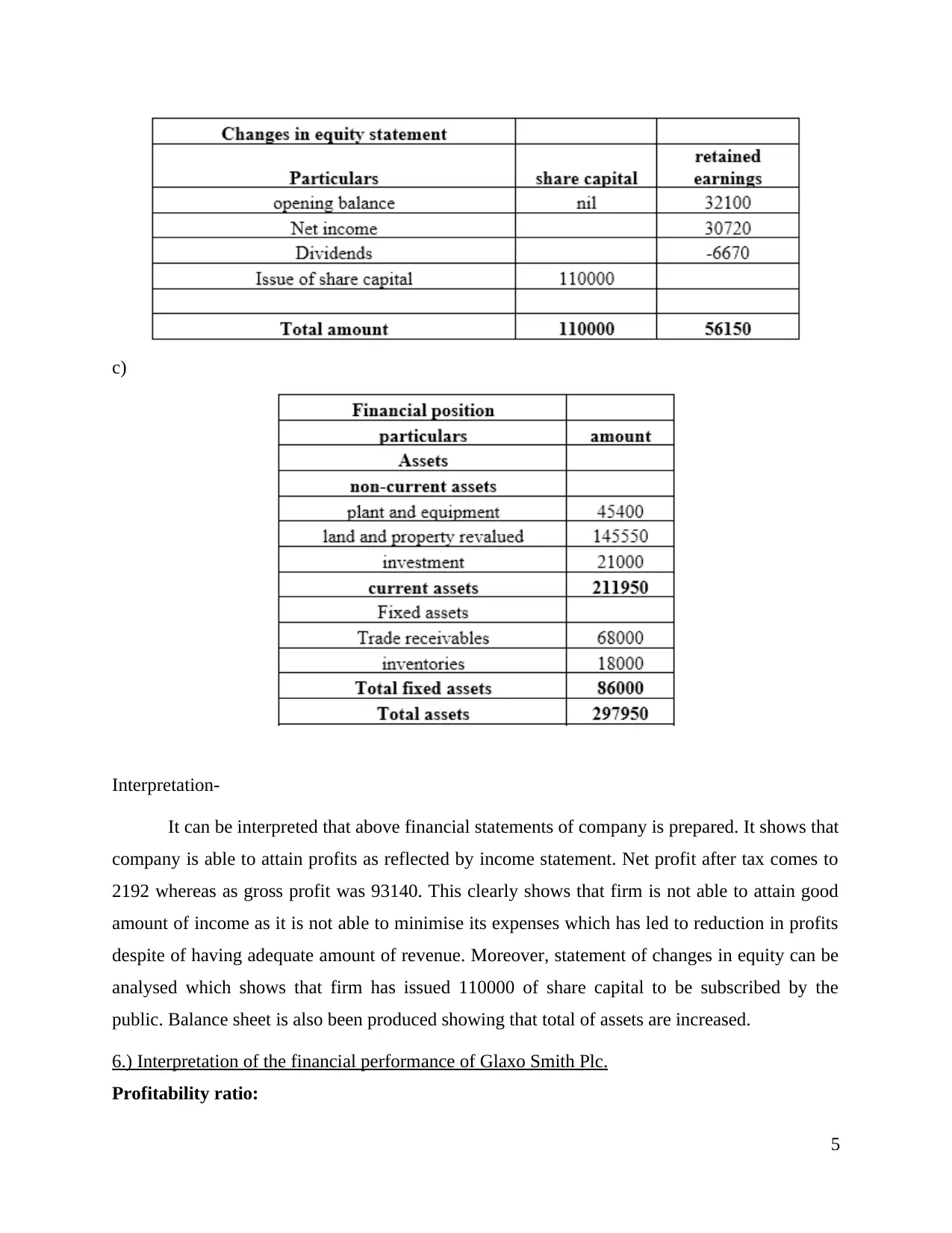
c)
Interpretation-
It can be interpreted that above financial statements of company is prepared. It shows that
company is able to attain profits as reflected by income statement. Net profit after tax comes to
2192 whereas as gross profit was 93140. This clearly shows that firm is not able to attain good
amount of income as it is not able to minimise its expenses which has led to reduction in profits
despite of having adequate amount of revenue. Moreover, statement of changes in equity can be
analysed which shows that firm has issued 110000 of share capital to be subscribed by the
public. Balance sheet is also been produced showing that total of assets are increased.
6.) Interpretation of the financial performance of Glaxo Smith Plc.
Profitability ratio:
5
Interpretation-
It can be interpreted that above financial statements of company is prepared. It shows that
company is able to attain profits as reflected by income statement. Net profit after tax comes to
2192 whereas as gross profit was 93140. This clearly shows that firm is not able to attain good
amount of income as it is not able to minimise its expenses which has led to reduction in profits
despite of having adequate amount of revenue. Moreover, statement of changes in equity can be
analysed which shows that firm has issued 110000 of share capital to be subscribed by the
public. Balance sheet is also been produced showing that total of assets are increased.
6.) Interpretation of the financial performance of Glaxo Smith Plc.
Profitability ratio:
5
⊘ This is a preview!⊘
Do you want full access?
Subscribe today to unlock all pages.

Trusted by 1+ million students worldwide
1 out of 30
Related Documents
Your All-in-One AI-Powered Toolkit for Academic Success.
+13062052269
info@desklib.com
Available 24*7 on WhatsApp / Email
![[object Object]](/_next/static/media/star-bottom.7253800d.svg)
Unlock your academic potential
Copyright © 2020–2025 A2Z Services. All Rights Reserved. Developed and managed by ZUCOL.





